Galaxy S8 vs Pixel: What’s the difference?
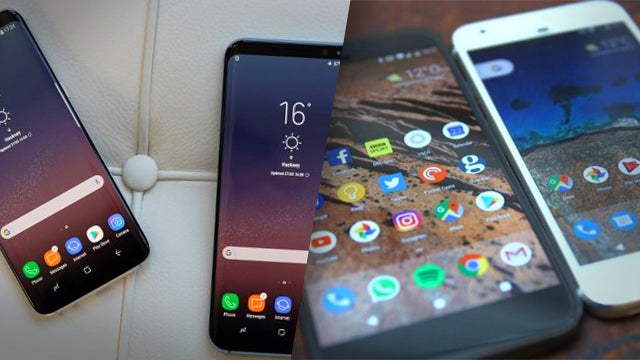
Galaxy S8 vs Google Pixel: The new Samsung flagship phone has finally arrived. Has Sammy beaten Google at its own game? We take a look.
Google’s Pixel phone is widely considered to be the best Android handset available. But before the Pixel arrived at the tail end of last year, Samsung was riding high with its Galaxy S7, and now it’s back with the Galaxy S8 – giving Google cause for worry.
The new S8 certainly looks very impressive on paper. A powerhouse in the hardware stakes, with a new design that gives you more screen and less bezel, and even its own AI assistant to rival Google’s own Google Assistant, this is a phone to be reckoned with.
But does the S8 really manage to outdo what might be the best Android handset out right now? Well, we might as well take a look.
Related: Galaxy S8 vs Galaxy S8+
Galaxy S8 vs Google Pixel Design: What’s the difference?
Let’s get this out of the way: the Galaxy S8, and its larger S8+ counterpart, are the best-looking phones you can buy. There’s no question here. Samsung has added curved edges to both the S8 and S8+, and they look incredible. Gentler than the curves on the S7 Edge, the sloping, newly-enlarged screen, looks fantastic, and marks a turning point in smartphone design – which has remained stale for some time.
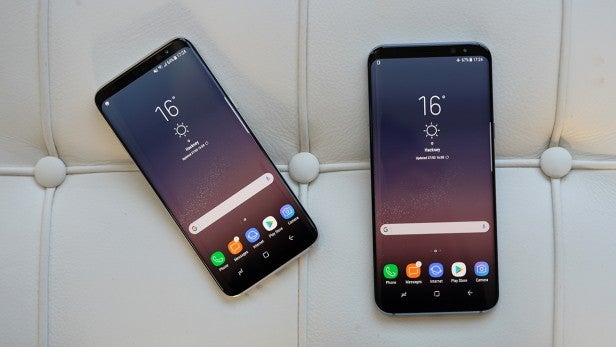 The Galaxy S8 and S8+
The Galaxy S8 and S8+
No home button, much smaller bezels, curved screen, glass back – the Galaxy S8 is the finest handset you can buy. Which means the Google Pixel was never going to win this won, but that doesn’t mean it’s ugly. It’s just… safe. It looks like the prototype model for every smartphone you’ve used in the past couple of years.
The body is made from metal and glass, and the bezels are about as big as any other phone from last year. The fingerprint sensor is on the back, much like on the new S8 and S8+, and the sides are heavily chamfered. It’s nice. Just not Galaxy S8 nice.
Perhaps the biggest difference between the S8 and the Pixel, or at least the most notable, is the display. Samsung calls its new 5.8-inch screen (6.2-inch on the S8+) an ‘Infinity Display’. That basically means it’s longer than on previous models, coming with a 18.5:9 aspect ratio. It looks stunning from a design perspective, but the Super AMOLED panel with 1440 x 2960 resolution also shows outstanding images. It’s also equipped with Mobile HDR tech so you can watch the latest HDR offerings from Netflix and Amazon.
No such luck on the Pixel, though you do get a 5-inch, 1080p display which, when we reviewed the phone, produced some impressive results. There’s just no question Samsung has the upper hand here, even when you take into account the Pixel XL‘s larger 5.5-inch screen, which comes with a more pixel-packed 1440 x 2560. Google also uses AMOLED tech on its phone, so you can at least rest assured blacks will be nice and inky, and energy consumption will be low.
Related: Galaxy S8 vs Galaxy S7
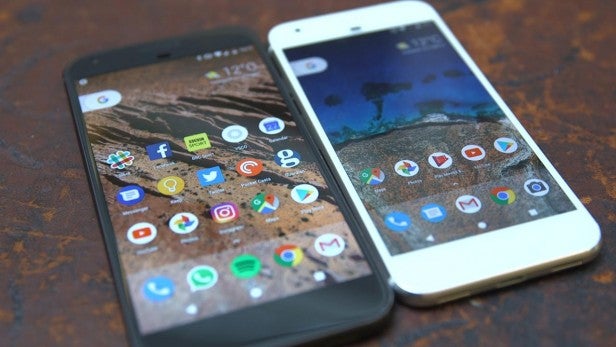 The Pixel and Pixel XL
The Pixel and Pixel XL
Speaking of measurements, the S8 comes in at 140.1 x 72.2 x 7.3mm, while the Plus model measures 152.4 x 78.5 x 7.9mm. Google’s handset measures 143.8 x 69.5 x 8.5mm, so it’s slightly longer and thicker than the S8. Considering you get a bigger screen on the latter, that’s pretty impressive for Samsung. The larger Pixel XL, meanwhile, comes in at 154.7 x 75.7 x 8.5mm.
Finally, you’ve got a choice of colours when it comes to Samsung’s phones. The S8 and S8+ are available in dark black, bright silver, or a grey with a blueish tinge. Google also offers different finishes in the form of the nauseatingly named “Quite Black”, “Very Silver”, and “Really Blue”.
All in all: Google Pixel looks good, Galaxy S8 looks better.
Galaxy S8 vs Google Pixel Specs: Which phone is the most powerful?
Sammy has whacked Qualcomm’s latest Snapdragon 835 chip in the US versions of the S8 and S8+, while those in the UK will be getting versions of the handsets with Samsung’s own Exynos 8895 chip. The Snapdragon comes with a load of new technology such as 25% better energy efficiency over the Snapdragon 820, Bluetooth 5 support, better graphics, and of course a more powerful octa-core CPU. But there’s no need to be concerned if you’re not getting the Snapdragon version. Both Qualcomm and Samsung’s chipsets are built on the new 10nm process and offer the latest hardware innovations.
Related: Galaxy S7
![]()
Those chips are backed up by 4GB of RAM which should make for some seriously speedy performance. Samsung neglected to up the RAM to 6GB, and in all honesty, 4GB of RAM with a Snapdragon 835 or Exynos 8895 is plenty to ensure lightning-fast performance. Alongside that, there’s 64GB of internal storage, plus a microSD card slot for those looking to expand the internal storage up to 256GB.
The Google Pixel and Pixel XL came out last year, and as such, don’t offer the very latest in phone hardware. But it’s important to note, the Snapdragon 821 at the heart of the Pixel is an incredibly fast processor that won’t run into any trouble with any app or game you throw at it. That comes along with 4GB of RAM and either 32 or 128GB of internal storage. In all, you probably won’t notice much difference in performance between the
There is, however, a difference in the battery department, Samsung offers a 3000mAh cell on the S8 which has us slightly concerned that the new large screen will drain the battery fully in a day, but we’re yet to test that out. The the larger S8+ comes with a 3500mAh offering, which should be enough to keep the thing going all day, but again, we’ll have to test this out.
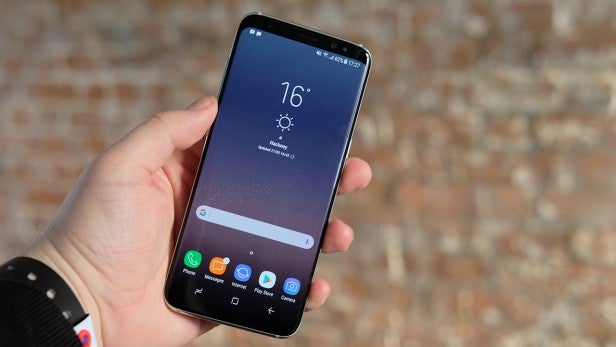
Google, on the other hand, has packed a 2770mAh battery in the Pixel, and although it’s smaller than the cell in the Galaxy S8, we did find it managed to keep the phone charged all day – though, you’ll need to charge the Pixel every night. The Pixel XL, on the other hand, comes with a 3450mAh battery, which keeps the phone running through the day and into the next.
Battery might be on area where Samsung has been outdone, then, but camera-wise, things should be quite even. You’ll find a 12-megapixel offering on the front. That’s the same megapixel count as last year, and, in all, not much has really changed since the S7. The big difference is that the S8 will now take three pictures when you tap the shutter, combining them together to create a shot with less blur and better colour accuracy.
The 12-megapixel sensor is backed up by an f/1.7 aperture and optical image stabilisation. The Dual Pixel tech also makes a return from last year. Seeing as the S7 had the best smartphone camera available in 2016, we’re not worried that little has changed this time. We’ll have more once we’ve actually used the handset for a prolonged period.
On the Pixel, you’ll find a 12.3-megapixel sensor with EIS and an f/2.0 aperture. On paper, it’s not quite up to S8 standards but we were incredibly impressed with the camera when we reviewed the Pixel and Pixel XL last year. It did a fantastic job of handling low-light shots, and in some cases surpassed its rivals, the iPhone 7 and Galaxy S7. It’s going to be interesting to see whether the S8 will be able to gain an edge in the camera stakes this year.
![]()
Elsewhere, you’ll find USB Type-C ports on both Samsung and Google’s handsets, but there’s a few areas where Sammy has the upper hand. First up is waterproofing. The S8 and S8+ come IP68–rated for full waterproofing while the Pixel doesn’t have any such protection. It also doesn’t have microSD card slot, or wireless charging, while Samsung’s phones offer both. The Pixel also lacks the new iris scanner that appears on the top bezel of the Galaxy S8.
Overall, the day-to-day performance of both handsets will be nothing short of stellar. Samsung’s handset, however, comes with a load of extras that give it the edge in terms of hardware and features.
Related: Best Android Phones 2017
For a full spec comparison, check out the table below:
| Galaxy S8 | Google Pixel | |
|---|---|---|
| Screen | 5.8 inches | 5 inches |
| Display Resolution | 1440 x 2960 pixels | 1080 x 1920 pixels (441ppi) |
| Screen-to-body Ratio | 84.4% | 69% |
| Aspect Ratio | 18.5:9 Infinity Display | 16:9 |
| Dimensions | 148.9 x 68.1 x 8.0mm | 143.8 x 69.5 x 8.5mm |
| Chipset | Qualcomm Snapdragon 835/Exynos 8895 | Qualcomm Snapdragon 821 |
| RAM | 4GB | 4GB |
| Storage | 64GB – expandable | 32 or 128GB |
| Rear Camera | 12-megapixel OIS, f/1.7 | 12.3-megapixel EIS, f/2.0 |
| Front Camera | 8-megapixel, f/1.7 auto focus | 8-megapixel, f/2.4 |
| Battery Size | 3000mAh | 2770mAh |
| Charging | Fast battery charging, Wireless | Fast battery charging |
| Headphone Jack | Yes | Yes |
| Waterproof | Yes (IP68 Certified) | No |
| Connectivity | Wi-Fi, 4G/LTE, USB-C | Wi-Fi, 4G/LTE, USB-C |
| Colours | Midnight, Grey and silver | Quite Black, Very Silver, Really Blue |
| Galaxy S8+ | Google Pixel XL | |
|---|---|---|
| Screen | 6.2 inches | 5.5 inches |
| Display Resolution | 1440 x 2960 pixels | 1440 x 2560 pixels (534ppi) |
| Screen-to-body Ratio | 88.6% | 71.2% |
| Aspect Ratio | 18.5:9 Infinity Display | 16:9 |
| Dimensions | 159.5 x 73.4 x 8.1mm | 154.7 x 75.7 x 8.5mm |
| Chipset | Qualcomm Snapdragon 835/Exynos 8895 | Qualcomm Snapdragon 821 |
| RAM | 4GB | 4GB |
| Storage | 64GB – expandable | 32 or 128GB – expandable |
| Rear Camera | 12-megapixel OIS, f/1.7 | 12.3-megapixel EIS, f/2.0 |
| Front Camera | 8-megapixel, f/1.7 auto focus | 8-megapixel, f/2.4 |
| Battery Size | 3500mAh | 3450mAh |
| Charging | Fast battery charging, Wireless | Fast battery charging |
| Headphone Jack | Yes | Yes |
| Waterproof | Yes (IP68 Certified) | No |
| Connectivity | Wi-Fi, 4G/LTE, USB-C | Wi-Fi, 4G/LTE, USB-C |
| Colours | Midnight black, Grey and silver | Quite Black, Very Silver, Really Blue |
Related: Best Android Apps 2017
Galaxy S8 vs Google Pixel OS: Which phone has better software?
Android 7.0 Nougat appears on both the Samsung and Google phones. It’s a great entry in the Android series, keeping all the good stuff from previous versions of the operating system and adding a load of new features to improve overall functionality. New features include richer drop-down menus, enhanced gaming with the addition of Vulkan API support, and multi-window multi-tasking. On top of that, a new Doze function will help conserve battery power, and revised notifications offer more options to interact with apps from the notification menu.
For a full breakdown of features, check out our comprehensive Android 7.0 Nougat guide.
Of course, one of the benefits of buying Google’s phone is that it comes with a completely untouched version of Android. Google uses its own devices to debut new versions of the OS, and the Pixel was the launch device for Nougat. There’s no proprietary skins overlaid on the standard OS on the Pixel phones, just pure Android goodness.
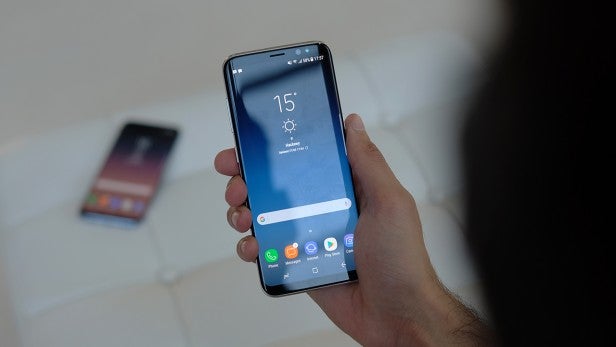
Samsung, on the other hand, is one of the companies that likes to add its own skin to the Android experience, and while TouchWiz, as it’s called, used to be a major drag, it’s now not too bad. In fact, the OS looks pretty good, with Samsung updating app icons to look a lot more mature, and making the skin far less intrusive. Last year saw the start of a much improved TouchWiz, and this year, Samsung may have just refined the skin to the point it’s actually a welcome addition.
Along with the new skin comes Bixby, Samsung’s own AI assistant. It’s the company’s attempt to rival the likes of Siri, Cortana, and of course, Google Assistant. Google made a big deal of debuting its new assistant – an upgraded version of Google Now – on the Pixel, but now it’s got even more competition. Bixby will be arriving with only Korean and US English built in, but those of us in the UK will have to wait for full support to arrive later in the year, along with other countries.
There’s a dedicated Bixby button on the side, and there’s a clever new camera feature that lets you scan items and search online for the best price. Whether it outdoes Google Assistant is yet to be seen, but we’ll have more soon.
Galaxy S8 vs Google Pixel Price: Which phone is better value for money?
UK pricing has been confirmed as £689 for the Galaxy S8 and £779 for the Galaxy S8+. That’s about what we were expecting, though it is a lot of money to spend.
![]()
The Google Pixel, on the other hand, can be picked up for around £600, while the Pixel XL is available for about £720. There are deals to be had now and then, of course, but on the whole, the Pixel phones are only slightly cheaper than the S8 and S8+, both of which come with significantly upgraded hardware.
Should you get the Galaxy S8 or the Google Pixel?
If you’re weighing up your options, here’s our advice about which phone you should buy.
If you want the best possible hardware, go for the S8. While there’s going to be very little difference when it comes to performance, the S8 simply has the latest and best hardware. If you’re a serious power user, the S8 is the best phone you can buy right now, at least on paper.
If you like a bigger screen, it’s all about the S8+. The S8+ comes with a massive 6.2-inch screen, but keeps the form factor relatively compact thanks to the lack of bezels allowing for more display real estate. If you’re going to be watching a lot of Netflix on the go, the Super AMOLED, pixel packed, large screen should be just what you need.
If you want a pure Android experience, the Pixel is the best bet. As it’s a Google phone, the Pixel comes with a standard, untouched version of Android, which for many, will be a big deal. Samsung’s skin isn’t bad – far from it – but if you like your Android Nougat pure, the Pixel is the way to go.
Consider the alternatives before purchasing either phone. The LG G6 launched earlier this year and comes with a similarly enlarged display to the new Galaxy phones, along with no home button. It’ll probably be around the same price as the S8, though, and the hardware isn’t quite as up to date as the S8’s – though it is about the same as the Pixel. If you’re looking to spend less there’s the OnePlus 3T which comes with the Snapdragon 821 of the Pixel but for under £400. And if you’re intrigued to see what Apple has in-store this year, the iPhone 8 will be arriving around September or October, so bear that in mind.
Galaxy S8 vs Google Pixel Summary: What’s the difference?
Here’s a brief overview of the key differences between the Galaxy S8 and Galaxy S8 Plus.
Design: There’s no competition here really. The Pixel looks good, but the S8 is a turning point in smartphone design, and simply looks great. It’s also waterproof and comes with a microSD card slot – both of which are lacking from Google’s handset.
Specs: While the Galaxy S8 is no doubt more powerful than the Pixel, in practice, you probably won’t notice much different. Both phones have great internals that will provide a smooth user experience. But, if you want to be precise, the S8’s Snapdragon 835/Exynos 8895 chips beat the Pixel’s Snapdragon 821 easily.
Price: The Galaxy S8 and S8+, can be picked up for £689 and £779 respectively. Google’s handset is available for £600, while the larger Pixel XL is on sale for around £720. That’s still likely to be cheaper than the Galaxy phones, but not by much.
Value: Seeing as there’s likely to be little difference between the S8 and Pixel in terms of price, we’d have to say the S8 takes this one, thanks to the upgraded hardware, stellar design, and extra features. And all for only slightly more than Google wants for its phone.
We’ll have more once we’ve done a full review of the Galaxy S8.
Let us know which phone you think clinches it in the comments below.

